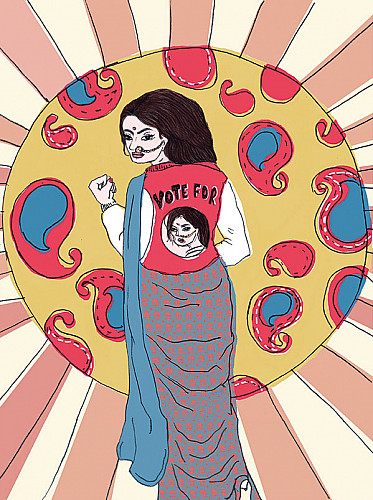The Hand That Rocks the Cradle….
Our country is a land full of contradictions. And this becomes all the more apparent when we talk about how women are treated in India. On the one hand, we worship Goddess Shakti — the primordial female energy that is at the core of life and well-being of the entire universe — and on the other, we read about the horrendous treatment of women, girls, and female foetuses. These actions aren’t two ends of a spectrum but rather part of a continuum, where many contradictions exist side by side. At the core, we must understand that this dichotomy is what we have to consider when we look at the role of women in politics in India.
During the last presidential elections in USA, an evident double standard for evaluating the two candidates was on display. As far as Hillary Clinton was concerned, she had to conform to a higher set of ‘good’ than Donald Trump. He was forgiven for his trespasses. She wasn’t. Part of the problem was her gender, and the American reluctance to accept a woman in their highest seat of power. India doesn’t seem to have that kind of obvious, blatant sexism. We aren’t thought of as being lesser in the workplace because of our gender. We may be paid less, but our ability is usually not in question.
As Charlotte Whitton, Canadian feminist and former mayor of Ottawa, observed, “Whatever women do, they must do twice as well as men to be thought half as good. Luckily, this is not difficult.” However, to do things better, even twice better, women must first get to a job that enables them to compete with others on an equal footing. And therein lies the crux of the problem. If you open the door to let us in, we will smash the glass ceiling. But, how do we get the door open wide enough to get in?
The statistics are abysmal. Worldwide, according to UN Women, 22.6 per cent of all national parliamentarians were women in 2016 — a slow crawl up from a lowly 11.3 per cent in 1995. India lags behind. We rank 148 out of 193 states, and 11.9 per cent of all our elected representatives in parliament are women. Out of the 543 elected Members of Parliament, only 62 are women. When it comes to individual states, the scenario is even worse. Women state legislators make up less than nine per cent of all state legislators. There are better figures at the local government level — primarily because a third of the seats are reserved for women (but most of these women are proxies for their more powerful husbands). In some areas, the women have broken out of their husbands’ shadows to forge an independent path for themselves. But, that tends to be the exception, not the norm.
Despite the number skew, India has produced some incredibly strong women political figures. Be it Indira Gandhi or Jayalalithaa, Mamata Banerjee or Sushma Swaraj, Mayawati or Sonia Gandhi, there has been no issue within the rank and file of the party, or, for that matter, the electorate accepting these women and following their leadership. They may have had their ups and downs, but neither the voter nor the party rank and file has seen them through a narrow gender lens. They are seen as political leaders who are women and not as women political leaders.
But, there is another aspect to this. Each of these women has positioned herself as the platonic mother or elder sister figure who is capable of bearing all pain for the greater good of the family. She is less threatening because she is the desexualised mother figure, who will take care of her large family. And, in India, irrespective of community or caste, we are used to obeying the mother figure unquestioningly. All the women named have been seen as effective administrators, who were compassionate to the needy, and who would yet not back away from a fight, but instead, fight to win. The ladies are formidable political leaders, and very few people in the political ecosystem would make the mistake of underestimating them. The presence of such women in politics should see an upsurge of other women participating in electoral politics, but unfortunately, that isn’t the case.
So, why are there so few women in the political arena? The answer is simple, because there aren’t too many women joining politics. And, this stems from an even more basic issue — to participate in politics, one needs a certain amount of economic independence. The participation of women in economic activity, in India, is very low. The labour force participation rate (LFPR) for women in India is 28.6 per cent which means that 71.4 per cent never earn money for the work that they do. This can have an impact on political participation. Secondly, most political participation of women in India tends to be based on ‘dynastic’ recommendations. Apart from Mayawati and Mamata Banerjee, most of the other women seem to come from political families. And, finally, when we look at party politics at the grass-roots level, what we see is a lot more men, and very few women. And, most women tend to avoid places that are dominated by men. However, the good news is that it is slowly changing. Social media and digital media allow women who are not from political families to create a footprint that propels them to the national stage. The need of the hour is for more women to exercise the option of joining politics.
So, what can be done to ensure that there are more women taking an active role in political life, be it in an elected or office-bearer role? At the starting level, more women must actively express interest and get involved in grass-roots politics. Both of the major national parties — the Bhartiya Janata Party (BJP) and the Indian National Congress (INC) — encourage professionals from all walks of life to volunteer with them at various levels. Regional parties also look for people. The thing about political parties is that they are always short of hands to do all the things they need to do, and there is always something that you can do. The second level, and this becomes slightly tougher, is to get involved at the local community level. The reason why many men get elected is because they are the ‘go-to’ guys to get things done. This involvement could start at the local school level, the local residents’ association level or even the ward and municipality level. Another way to achieve this is to throw your weight behind the Women’s Reservation Bill. The now-lapsed 108th amendment proposed that one third of all seats in parliament be reserved for women. That bill will ensure that a third of all Members of Parliament are women. Unless men, who have hitherto held the reins of power, are compelled, they aren’t going to give up power. And, the only way to ensure they do, is this bill.
Related posts from Verve:
Verve Trending
Sorry. No data so far.
us on Facebook to stay updated with the latest trends






